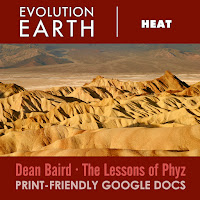It's not always clear to me why certain documentary properties are picked up by NOVA while others run "independently" on PBS. In the end, I'm not sure it's critically important.
In autumn, 2023, two series are running on PBS that constitute a popular social media meme.
How it started : How it's going. The it here is Life on Earth.
How it started is documented in Ancient Earth (BBC/NOVA). It chronicles the events that transpired to bring Earth from a lifeless rock to planet bustling with living organisms. And yes, I have questions!
How it's going is documented in Evolution Earth (PBS). It details contemporary evolution in progress, often spurred by human impact on the environment.
Both series tell their stories across five episodes.
Evolution Earth embarks on a global expedition to reveal the animals keeping pace with a planet changing at superspeed. Heading out across the globe to distant wilds and modern urban environments, five episodes track how animals are moving, using ingenuity to adapt their behavior, and even evolving in unexpected ways.At the front lines of this rapid change are the scientists, filmmakers and local communities recording the animals’ stories. We follow heart-warming tales of resilience that redefine our understanding of evolution, and hint at how nature can show us a path towards a sustainable future for Planet Earth.The series is narrated by Dr. Shane Campbell-Staton, who guides us through each episode in an intimate narrative style, drawing on his background as an evolutionary biologist.
At Earth’s extremes, animals are reacting in surprising ways. Animal homes are changing around them at superspeed. Follow remarkable stories of resilience and hope. From humpback whales to tiny butterflies to ingenious savanna chimpanzees.
Segments: Savanna Chimpanzees · Coastal Humpback Whales · Edith’s Checkerspot Butterflies · Mountain Pine Beetles · Marine Iguanas
Cover Photo: Marine iguanas and a finch enjoying each others' company on a beach in the Galápagos islands, August 2008.
Islands are like miniature simplified Earths, where evolution is playing out at super speed right before our eyes. Journey from the Galapagos to the edge of Antarctica to seek out animals responding to our changing planet in extraordinary ways.
Segments: Sea Lions · Finches · Silver Key Anoles · Pacific Field Crickets · South Georgia Pipits · Red Colobus Monkeys · Mangrove Forests
Cover Photo: Fur seal eyes a Galápagos lava lizard. Galápagos islands, August 2008. [I confess to the faux pas of representing the sea lion and and Silver Key anole with a fur seal and lava lizard, but the photo was too much fun not to use.]
Travel to the hottest and driest extremes to see animals go to extraordinary lengths to survive. From the Sahara Desert to Australia, animals provide new clues about our changing planet and what it will mean for the future of our heating world.
Segments: Savanna Chimpanzees II · Nubian Ibex · Saharan Silver Ants · Zebra Finches · Atomic Camels · People of the Sahara
Cover Photo: Death Valley, December 2005. The desert locations used in the episode are a bit more far-flung (Sahara and Gobi, for example.) But I like what I captured in Death Valley years ago. I'll only go there from November through March.
At the planet’s frozen extremes, shifts in animal movement and behavior reveal vital information about our future world. Examine polar bears in the Arctic, penguins in Antarctica and other animals surviving in icy worlds.
Segments: Polar Bears · Mountain Hares · Gentoos and Adélies · Billy Barr · Wandering Albatross Winds · Lemmings and Foxes · The Sámi and Their Reindeer Herds
Cover Photo: A Polar Bear in the Pack Ice, July 2018. We had to sail to 83°N to find polar bears north of Svalbard. Once you spot one, you plow your boat into the ice and stop the engines. The bear will come to you. They're curious as to this new thing in their desolate environment, and must investigate.
Segments: The Serengeti: Wildebeest and Dung Beetles · Patagonia: Guanacos, Pumas · American Prairies: Butterflies, Bison, Prairie Dogs, Oaks, Grasshoppers, and Roots
Cover Photo: The Sun Sets on Theodore Roosevelt National Park, July 2022. This North Dakota national park includes acres and acres of grasslands.



















